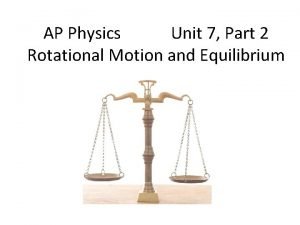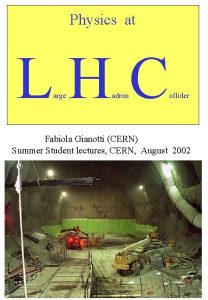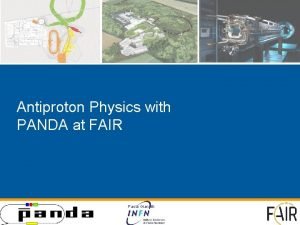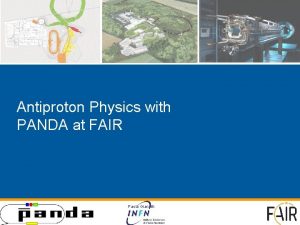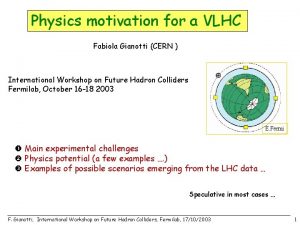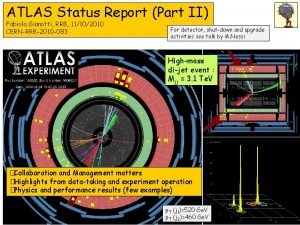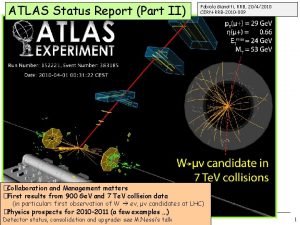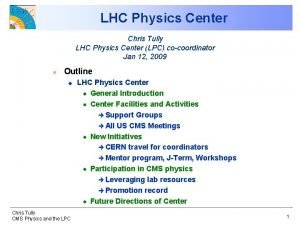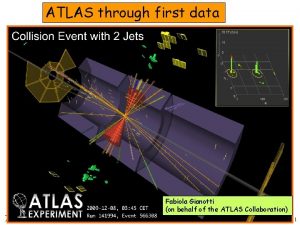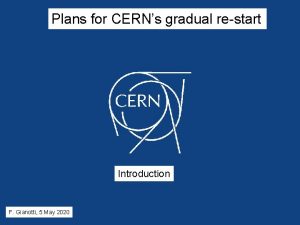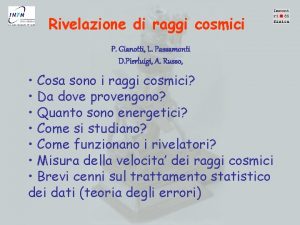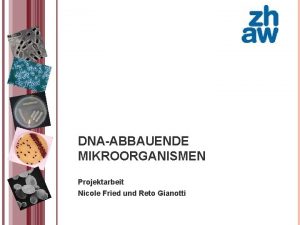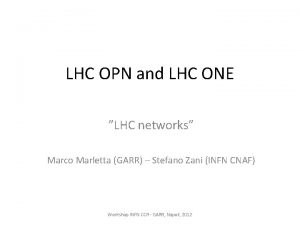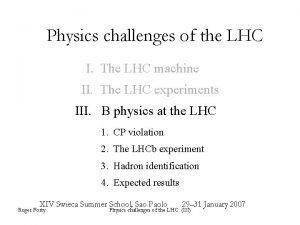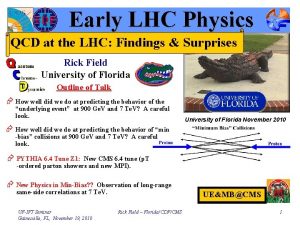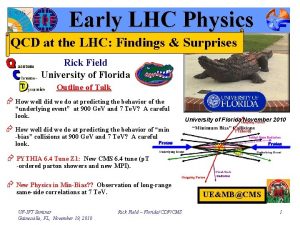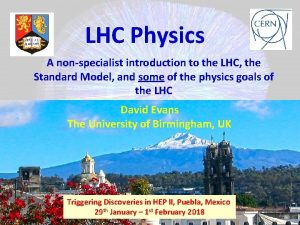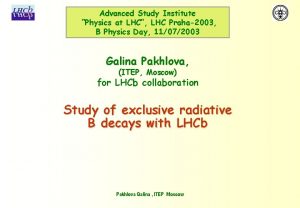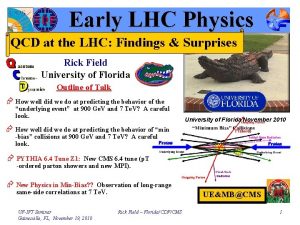PART 2 F Gianotti LHC Physics The LHC









































- Slides: 41

PART 2 F. Gianotti, LHC Physics

The LHC physics programme • Search for Standard Model Higgs boson over ~ 115 < m. H < 1000 Ge. V. • Search for Supersymmetry and other physics beyond the SM (q/ compositness, leptoquarks, W’/Z’, heavy q/ , unpredicted ? …. ) up to masses of ~ 5 Te. V • Precise measurements : -- W mass -- WW , WWZ Triple Gauge Couplings -- top mass, couplings and decay properties -- Higgs mass, spin, couplings (if Higgs found) -- B-physics: CP violation, rare decays, B 0 oscillations (ATLAS, CMS, LHCb) -- QCD jet cross-section and as -- etc. …. • Study of phase transition at high density from hadronic matter to plasma of deconfined quarks and gluons. Transition plasma hadronic matter happened in universe ~ 10 -5 s after Big Bang (ALICE) F. Gianotti, LHC Physics

Keyword: large event statistics Expected event rates in ATLAS/CMS for representative (known and new) physics processes at low luminosity (L=1033 cm-2 s-1) Process Events/year Other machines (total statistics) W e Z ee 15 1. 5 108 107 104 LEP / 107 Tev. 0. 8 107 104 Tevatron 105 1012 108 Belle/Ba. Bar 0. 001 104 107 LEP (m=1 Te. V) H 0. 02 105 (m=130 Ge. V) QCD jets p. T > 200 Ge. V 102 109 107 High L : statistics 10 times larger LHC is a B-factory, top factory, W/Z factory Higgs factory, SUSY factory, etc…. F. Gianotti, LHC Physics

Precise measurements of: m. W , mtop F. Gianotti, LHC Physics

Motivation: W mass and top mass are fundamental parameters of the Standard Model: Electromagnetic constant measured in atomic transitions, e+e- machines, etc. Fermi constant measured in muon decay Weinberg angle measured at LEP/SLC radiative corrections r ~ f (mtop 2, log m. H) r 3% since GF, a. EM, sin W are known with high precision, precise measurements of mtop and m. W constrain radiative corrections and Higgs mass (weakly because of logarithmic dependence) So far : W mass measured at LEP 2 and Tevatron top mass measured at the Tevatron F. Gianotti, LHC Physics

m. W (from LEP 2 + Tevatron) = 80. 426 0. 034 Ge. V mtop (from Tevatron) = 174. 3 5. 1 Ge. V 4 • 10 -4 3% Direct measurements m. H dependence in SM through radiative corrections light Higgs is favoured F. Gianotti, LHC Physics

Year 2007: m. W 20 Me. V (0. 3 ‰) from LEP/Tevatron mtop 2 Ge. V (1%) from Tevatron Can LHC do better YES F. Gianotti, LHC Physics ? : thanks to large statistics

Measurement of W mass Method used at hadron colliders different from e+e- colliders • W jet : cannot be extracted from QCD jet-jet production cannot be used • W t : since t + X , too many undetected neutrinos cannot be used only W e and W m decays are used to measure m. W at hadron colliders F. Gianotti, LHC Physics

W production at LHC : Ex. q W q’ (pp W + X) 30 nb e , m ~ 300 106 events produced ~ 60 106 events selected after analysis cuts one year at low L, per experiment ~ 50 times larger statistics than at Tevatron ~ 6000 times larger statistics than WW at LEP F. Gianotti, LHC Physics

W e events (data) from CDF experiment at the Tevatron F. Gianotti, LHC Physics

Since not known (only can be measured through ETmiss), measure transverse mass, i. e. invariant mass of in plane perpendicular to the beam : ETmiss F. Gianotti, LHC Physics

m. TW distribution is sensitive to m. W= 79. 8 Ge. V m. W= 80. 3 Ge. V m. TW distribution expected in ATLAS m. TW (Ge. V) fit experimental distributions with SM prediction (Monte Carlo simulation) for different values of m. W find m. W which best fits data F. Gianotti, LHC Physics

Uncertainties on m. W Come mainly from capability of Monte Carlo prediction to reproduce real life, that is: • detector performance: energy resolution, energy scale, etc. • physics: p. TW, W, GW, backgrounds, etc. Dominant error (today at Tevatron, most likely also at LHC): knowledge of lepton energy scale of the detector: if measurement of lepton energy wrong by 1%, then measured m. W wrong by 1% F. Gianotti, LHC Physics

Calibration of detector energy scale Example : EM calorimeter e- beam E = 100 Ge. V CALO Emeasured • if Emeasured = 100. 000 Ge. V calorimeter is perfectly calibrated • if Emeasured = 99, 101 Ge. V energy scale known to 1% • to measure m. W to ~ 20 Me. V need to know energy scale to 0. 2 ‰ , i. e. if E electron = 100 Ge. V then 99. 98 Ge. V < Emeasured < 100. 02 Ge. V one of most serious experimental challenges F. Gianotti, LHC Physics

Calibration strategy: • detectors equipped with calibration systems which inject known pulses: in in out cell check that all cells give same response: if not correct • calorimeter modules calibrated with test beams of known energy set the energy scale • inside LHC detectors: calorimeter sits behind inner detector electrons lose energy in material of inner detector need a final calibration “ in situ ” by using physics samples: e. g. Z e+ e- decays 1/sec at low L constrain mee = m. Z reconstructed F. Gianotti, LHC Physics known to 10 -5 from LEP

Expected precision on m. W at LHC Source of uncertainty m. W Statistical error << 2 Me. V Physics uncertainties (p. TW, W, GW, …) ~ 15 Me. V Detector performance (energy resolution, lepton identification, etc, ) Energy scale Total < 10 Me. V 15 Me. V ~ 25 Me. V (per experiment, per channel) Combining both channels (e , m ) and both experiments (ATLAS, CMS), m. W 15 Me. V should be achieved. However: very difficult measurement F. Gianotti, LHC Physics

Measurement of mtop • Top is most intriguing fermion: -- mtop 174 Ge. V clues about origin of particle masses ? -- u d c s t b m (t-b) 170 Ge. V radiative corrections • Discovered in ‘ 94 at Tevatron precise measurements of mass, couplings, etc. just started tt b bjj events Top mass spectrum from CDF F. Gianotti, LHC Physics S+B B

Top production at LHC: e. g. g t q t (pp 107 + X) 800 pb pairs produced in one year at low L ~ 102 times more than at Tevatron measure mtop, tt, BR, Vtb, single top, rare decays (e. g. t Zc), resonances, etc. production is the main background to new physics (SUSY, Higgs) F. Gianotti, LHC Physics

Top decays: t W BR 100% in SM b -- hadronic channel: both W jj 6 jet final states. BR 50 % but large QCD multijet background. -- leptonic channel: both W 2 jets + 2 + ETmiss final states. BR 10 %. Little kinematic constraints to reconstruct mass. -- semileptonic channel: one W jj , one W 4 jets + 1 + ETmiss final states. BR 40 %. If = e, m : gold-plated channel for mass measurement at hadron colliders. In all cases two jets are b-jets displaced vertices in the inner detector F. Gianotti, LHC Physics

Example from CDF : tt Wb Wb b bjj event W- , m = 79 Ge. V (b) l 1=4. 5 mm l 2=2. 2 mm e+ W+ Jet 4 (b) Secondary vertices t(b-hadrons) ~ 1. 5 ps decay at few mm from primary vertex detected with high-granularity Si detector (b-tagging) ATLAS t bjj Selection : -- two b-tagged jets -- one lepton -- ETmiss > 20 Ge. V -- two more jets with |mjj-m. W| < 20 Ge. V F. Gianotti, LHC Physics

Expected precision on mtop at LHC Source of uncertainty mtop Statistical error << 100 Me. V Physics uncertainties (background, FSR, ISR, fragmentation, etc. ) ~ 1. 3 Ge. V Jet scale (b-jets, light-quark jets) Total (per experiment, per channel) ~ 0. 8 Ge. V ~ 1. 5 Ge. V • Uncertainty dominated by the knowledge of physics and not of detector. • By combining both experiments and all channels : mtop ~ 1 Ge. V at LHC From mtop ~ 1 Ge. V, m. W ~ 15 Me. V indirect measurement m. H/m. H ~ 25% (today ~ 50%) If / when Higgs discovered, comparison of measured m. H with indirect measurement will be essential consistency checks of EWSB F. Gianotti, LHC Physics

Searches for the Standard Model Higgs boson Where is the Higgs ? F. Gianotti, LHC Physics

What do we know today about it ? • • Needed in SM to generate particle masses Mass not predicted by theory except that m. H < 1000 Ge. V m. H > 114. 4 Ge. V from direct searches at LEP Indirect limits from fit of SM to: -- LEP 1/SLD precise measurements at s = m. Z -- m. W measurement LEP 2/Tevatron -- mtop measurement at Tevatron Best fit of SM to data (minimum 2) found for +58 Ge. V m. H= 91 -37 m. H < 211 Ge. V 95% C. L. Higgs could be around the corner ! • 1. 7 excess from LEP for m. H ~ 115 Ge. V • Higgs production and decays versus m. H predicted F. Gianotti, LHC Physics

Higgs production at LHC gg fusion associated WW/ZZ fusion associated WH, ZH Cross-section for pp H + X F. Gianotti, LHC Physics

Higgs decays H f ~ mf Decay branching ratios (BR) • m. H < 130 Ge. V: H dominates • m. H 130 Ge. V : H WW(*), ZZ(*) dominate • important rare decays : H Dominant fully hadronic final states (inclusive H bb, H WW 4 jets, H ZZ 4 jets) cannot be extracted from QCD background look for H , H ZZ 4 , H WW , etc. F. Gianotti, LHC Physics

How can one claim a discovery ? Suppose a new narrow particle X is produced: peak width due to detector resolution m Signal significance : NS= number of signal events NB= number of background events in peak region NB error on number of background events S > 5 : signal is larger than 5 times error on background. Probability that background fluctuates up by more than 5 : 10 -7 discovery F. Gianotti, LHC Physics

Two critical parameters to maximise S: • detector resolution: if m increases by e. g. two, then need to enlarge peak region by two. NB increases by ~ 2 (assuming background flat) decreases by 2 NS unchanged S 1 / m S =NS/ NB detector with better resolution has larger probability to find a signal Note: only valid if GH << m. If Higgs is broad detector resolution is not relevant. GH ~ m. H 3 GH ~ Me. V (~100 Ge. V) m. H =100 (600) Ge. V • integrated luminosity : NS ~ L NB ~ L F. Gianotti, LHC Physics S ~ L

m. H 150 Ge. V H H W* W* W* BR 50 fb m. H 100 Ge. V • Select events with two photons in the detector with p. T ~ 50 Ge. V • Measure energy and direction of each photon • Measure invariant mass of photon pair • Plot distribution of m Higgs should appear as a peak at m. H Most challenging channel for LHC electromagnetic calorimeters F. Gianotti, LHC Physics

Main backgrounds: • production: irreducible (i. e. same final state as signal) e. g. : q g 60 m ~ 100 Ge. V • jet + jet production where one/two jets fake photons: reducible e. g. : q g q F. Gianotti, LHC Physics ~ 108 p 0 (s)

• Reducible jet, jet-jet background : need excellent /jet separation (in particular /p 0 separation) to reject jet faking ATLAS EM calorimeter : 4 mm strips in first compartment Rjet 103 achieved for 80% Adequate to reject this background well below irreducible backgund F. Gianotti, LHC Physics

• Irreducible : cannot be reduced. But signal can be extracted from background if mass resolution good enough GH < 10 Me. V for m. H ~ 100 Ge. V energy resolution of EM calorimeter F. Gianotti, LHC Physics resolution of the measurement of the angle

ATLAS EM calorimeter: • liquid-argon/lead sampling calorimeter • longitudinal segmentation can measure direction m 1. 3 Ge. V m. H ~100 Ge. V 30% CMS EM calorimeter: vertex spread ~ 5. 6 cm • homogeneous crystal calorimeter • no longitudinal segmentation vertex measured using secondary tracks from spectator partons difficult at high L often pick up the wrong vertex m 0. 7 Ge. V m. H ~100 Ge. V 20% similar significance of both experiments within ~ 10% S ~ 1/ m S ~ F. Gianotti, LHC Physics

CMS crystal calorimeter F. Gianotti, LHC Physics

F. Gianotti, LHC Physics

Expected performance 100 fb-1 CMS m. H (Ge. V) 120 Significance per experiment with 100 fb-1 ~ 6. 5 F. Gianotti, LHC Physics 150 ~ 4. 5

H ZZ(*) 4 120 m. H < 700 Ge. V e, m H Z(*) Z e, m m. Z • “Gold-plated” channel for Higgs discovery at LHC • Select events with 4 high-p. T leptons (t excluded): e+e-, m+m-, e+e- m+m- • Require at least one lepton pair consistent with Z mass • Plot 4 invariant mass distribution : Higgs signal should appear as peak in the mass distribution F. Gianotti, LHC Physics

Backgrounds: -- irreducible : pp ZZ (*) 4 m (H 4 ) 1 -1. 5 Ge. V ATLAS, CMS For m. H > 300 Ge. V GH > m -- reducible ( ~ 100 fb) : W t, t b g b Z g b Both rejected by asking: -- m ~ m. Z -- leptons are isolated -- leptons come from interaction vertex ( B lifetime : ~ 1. 5 ps leptons from B produced at 1 mm from vertex) F. Gianotti, LHC Physics

Expected performance • Significance : 3 -25 (depending on mass) for 30 fb-1 • Observation possible up to m 700 Ge. V H • For larger masses: -- (pp H) decreases -- GH > 100 Ge. V H ZZ* 4 ATLAS, 30 fb-1 F. Gianotti, LHC Physics

F. Gianotti, LHC Physics

F. Gianotti, LHC Physics

Summary of Part 2 • Examples of precision physics at LHC: W mass can be measured to ~15 Me. V, top mass to ~ 1 Ge. V Higgs mass constrained indirectly to ~ 25% • Standard Model Higgs boson can be discovered over the full mass region up to 1 Te. V in ~ 1 year of operation. final word about SM Higgs mechanism • Excellent detector performance required: Higgs searches have driven the LHC detector design. • Among main channels : H , H 4 • If SM Higgs not found before/at LHC, then alternative methods for Electroweak Symmetry Breaking will have to be found End of Part 2 F. Gianotti, LHC Physics
 Roseole ste justine
Roseole ste justine Lhc tantalizing new physics
Lhc tantalizing new physics Why does it happen
Why does it happen University physics with modern physics fifteenth edition
University physics with modern physics fifteenth edition Physics ia topic ideas
Physics ia topic ideas Translational and rotational equilibrium
Translational and rotational equilibrium Hát kết hợp bộ gõ cơ thể
Hát kết hợp bộ gõ cơ thể Lp html
Lp html Bổ thể
Bổ thể Tỉ lệ cơ thể trẻ em
Tỉ lệ cơ thể trẻ em Gấu đi như thế nào
Gấu đi như thế nào Chụp phim tư thế worms-breton
Chụp phim tư thế worms-breton Chúa sống lại
Chúa sống lại Môn thể thao bắt đầu bằng chữ đua
Môn thể thao bắt đầu bằng chữ đua Thế nào là hệ số cao nhất
Thế nào là hệ số cao nhất Các châu lục và đại dương trên thế giới
Các châu lục và đại dương trên thế giới Cong thức tính động năng
Cong thức tính động năng Trời xanh đây là của chúng ta thể thơ
Trời xanh đây là của chúng ta thể thơ Cách giải mật thư tọa độ
Cách giải mật thư tọa độ 101012 bằng
101012 bằng độ dài liên kết
độ dài liên kết Các châu lục và đại dương trên thế giới
Các châu lục và đại dương trên thế giới Thể thơ truyền thống
Thể thơ truyền thống Quá trình desamine hóa có thể tạo ra
Quá trình desamine hóa có thể tạo ra Một số thể thơ truyền thống
Một số thể thơ truyền thống Cái miệng nó xinh thế
Cái miệng nó xinh thế Vẽ hình chiếu vuông góc của vật thể sau
Vẽ hình chiếu vuông góc của vật thể sau Nguyên nhân của sự mỏi cơ sinh 8
Nguyên nhân của sự mỏi cơ sinh 8 đặc điểm cơ thể của người tối cổ
đặc điểm cơ thể của người tối cổ Thứ tự các dấu thăng giáng ở hóa biểu
Thứ tự các dấu thăng giáng ở hóa biểu Vẽ hình chiếu đứng bằng cạnh của vật thể
Vẽ hình chiếu đứng bằng cạnh của vật thể Phối cảnh
Phối cảnh Thẻ vin
Thẻ vin đại từ thay thế
đại từ thay thế điện thế nghỉ
điện thế nghỉ Tư thế ngồi viết
Tư thế ngồi viết Diễn thế sinh thái là
Diễn thế sinh thái là Dot
Dot Các số nguyên tố là gì
Các số nguyên tố là gì Tư thế ngồi viết
Tư thế ngồi viết Lời thề hippocrates
Lời thề hippocrates Thiếu nhi thế giới liên hoan
Thiếu nhi thế giới liên hoan





